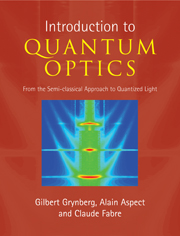Book contents
- Frontmatter
- Contents
- Foreword
- Preface
- Acknowledgements
- Part I Semi-classical description of matterlight interaction
- Part II Quantum description of light and its interaction with matter
- 4 Quantization of free radiation
- Complement 4A: Example of the classical Hamiltonian formalism: charged particle in an electromagnetic field
- Complement 4B: Momentum and angular momentum of radiation
- Complement 4C: Photons in modes other than travelling plane waves
- 5 Free quantum radiation
- Complement 5A: Squeezed states of light: the reduction of quantum fluctuations
- Complement 5B: One-photon wave packet
- Complement 5C: Polarization-entangled photons and violation of Bell's inequalities
- Complement 5D: Entangled two-mode states
- Complement 5E: Quantum information
- 6 Interaction of an atom with the quantized electromagnetic field
- Complement 6A: Hamiltonian formalism for interacting fields and charges
- Complement 6B: Cavity quantum electrodynamics
- Complement 6C: Polarization-entangled photon pairs emitted in an atomic radiative cascade
- Part III Applying both approaches
- Index
5 - Free quantum radiation
Published online by Cambridge University Press: 05 August 2012
- Frontmatter
- Contents
- Foreword
- Preface
- Acknowledgements
- Part I Semi-classical description of matterlight interaction
- Part II Quantum description of light and its interaction with matter
- 4 Quantization of free radiation
- Complement 4A: Example of the classical Hamiltonian formalism: charged particle in an electromagnetic field
- Complement 4B: Momentum and angular momentum of radiation
- Complement 4C: Photons in modes other than travelling plane waves
- 5 Free quantum radiation
- Complement 5A: Squeezed states of light: the reduction of quantum fluctuations
- Complement 5B: One-photon wave packet
- Complement 5C: Polarization-entangled photons and violation of Bell's inequalities
- Complement 5D: Entangled two-mode states
- Complement 5E: Quantum information
- 6 Interaction of an atom with the quantized electromagnetic field
- Complement 6A: Hamiltonian formalism for interacting fields and charges
- Complement 6B: Cavity quantum electrodynamics
- Complement 6C: Polarization-entangled photon pairs emitted in an atomic radiative cascade
- Part III Applying both approaches
- Index
Summary
In this chapter we shall be using the formalism of Chapter 4 to describe some properties of the quantized free electromagnetic field, emphasizing the analogies and differences with classical electromagnetism. The analogies explain why classical optics was so successful, to the extent that, even though light was not quantized, it was able to describe almost all known optical phenomena up until the 1970s. The differences highlight typical quantum behaviour, with no classical equivalent, which lies at the heart of modern quantum optics.
The chapter begins by presenting formal ways of describing the main components of quantum optics experiments, namely, photodetectors and semi-reflecting mirrors. One can then understand homodyne detection, used to measure field quadrature components, even at optical frequencies for which no detector is fast enough to follow the oscillations of the field itself.
Section 5.2 deals with the quantum vacuum where, in contrast to the classical vacuum, radiation has properties, in particular, fluctuations, with which one can associate physical effects.
We then discuss in Section 5.3 some quantum radiation states in the simple case where a single mode l of the field is excited (non-vacuum). We introduce the idea of a quasiclassical state, or coherent state, used to make the link with classical optics. We shall also study other states, those with a definite number of photons, or squeezed states, which exhibit typically quantum properties, quite inconceivable in classical electromagnetism, and we shall show how these properties can be understood by reference to the Heisenberg relations, with an extremely useful graphical representation.
- Type
- Chapter
- Information
- Introduction to Quantum OpticsFrom the Semi-classical Approach to Quantized Light, pp. 341 - 386Publisher: Cambridge University PressPrint publication year: 2010



